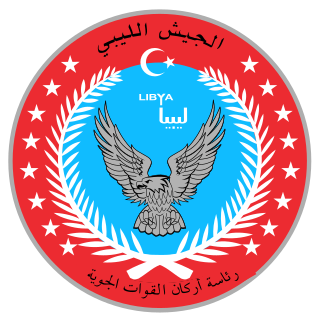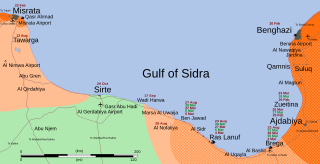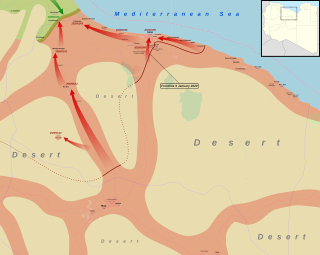
Misrata is a city in northwestern Libya located in the Misrata District, situated 187 km (116 mi) to the east of Tripoli on the Mediterranean coast near Cape Misrata. With a population of about 881,000, it is the third-largest city in Libya, after Tripoli and Benghazi. It is the capital city of the Misrata District and has been called the economic and trade capital of Libya. Its harbor is at Qasr Ahmad.

Sirte, also spelled Sirt, Surt, Sert or Syrte, is a city in Libya. It is located south of the Gulf of Sirte, almost right in the middle between Tripoli and Benghazi. It is famously known for its battles, ethnic groups and loyalty to former Libyan ruler Muammar Gaddafi. Due to developments in the First Libyan Civil War, it was briefly the capital of Libya as Tripoli's successor after the Fall of Tripoli from 1 September to 20 October 2011. The settlement was established in the early 20th century by the Italians, at the site of a 19th-century fortress built by the Ottomans. It grew into a city after World War II.

The Libyan Air Force is the aerial warfare branch of the Libyan Armed Forces. In 2010, before the First Libyan Civil War, the Libyan Air Force personnel strength was estimated at 18,000, with an inventory of 374 combat-capable aircraft operating from 13 military airbases in Libya. Since the aftermath first civil war in 2011 and the outbreak of the Second Libyan Civil War, multiple factions fighting in Libya have been in possession of military aircraft. As of 2019, the Libyan Air Force is nominally under the control of the internationally recognised Government of National Accord in Tripoli, though the rival Libyan National Army of Marshal Khalifa Haftar also has a significant air force. In 2021, the air force was under command of the new President of Libya, Mohamed al-Menfi that replaced Fayez al-Sarraj.

The Chengdu GJ-1, also known as Wing Loong 1, is a Medium-Altitude Long-Endurance (MALE) unmanned aerial vehicle (UAV), developed by the Chengdu Aircraft Industry Group in the People's Republic of China. Intended for use as a surveillance and aerial reconnaissance platform, the Pterodactyl I is capable of being fitted with air-to-surface weapons for use in an unmanned combat aerial vehicle (UCAV) role.

The Libyan Civil War began on 17 February 2011 as a civil protest and later evolved into a widespread uprising. By mid-August, anti-Gaddafi forces effectively supported by a NATO-led international coalition were ascendant in Tripolitania, breaking out of the restive Nafusa Mountains in the south to mount an offensive toward the coast and advancing from Misrata on loyalist-held cities and villages from the north and east.

The National Liberation Army, officially the National Liberation Armed Forces of the Free Libyan Republic, formerly known as the Free Libyan Army, was a Libyan military organisation affiliated with the National Transitional Council, which was constituted during the First Libyan Civil War by defected military members and civilian volunteers, in order to engage in battle against both remaining members of the Libyan Armed Forces and paramilitia loyal to the rule of Muammar Gaddafi. Its self proclaimed chief commander was General Khalifa Haftar, although the National Transitional Council preferred to appoint Major General Abdul Fatah Younes Al-Obeidi as its commander-in-chief. It had prepared for some time in portions of Eastern Libya controlled by the anti-Gaddafi forces for eventual full-on combat in Western Libya against pro-Gaddafi militants, training many men before beginning to go on the offensive. They have battled for control of Benghazi, Misrata, Brega, Ajdabiya, Zawiya and Ra's Lanuf as well as several towns in the Nafusa Mountains. They finally began the Battle for Tripoli in August 2011 when they attacked from the west of the city, as well as fomenting an internal uprising on 20 August.

The timeline of the Libyan civil war begins on 15 February 2011 and ends on 20 October 2011. The conflict began with a series of peaceful protests, similar to others of the Arab Spring, later becoming a full-scale civil war between the forces loyal to Muammar Gaddafi's government and the anti-Gaddafi forces. The conflict can roughly be divided into two periods before and after external military intervention authorized by United Nations Security Council Resolution 1973.
The Battle of Tawergha was a military engagement of the Libyan Civil War that began on 11 August 2011 when anti-Gaddafi forces based in Misrata advanced southeast along the road to Sirte in the early morning and attacked Libyan Army positions in the town of Tawergha. It ended on 13 August when rebel troops, after capturing the town, cleared it of snipers and artillery positions threatening Misrata.

The Second Gulf of Sidra offensive was a military operation in the First Libyan Civil War conducted by rebel anti-Gaddafi forces in August and September 2011 to take control of towns along the Gulf of Sidra in an effort to surround Muammar Gaddafi's hometown of Sirte, which was held by pro-Gaddafi forces. The offensive ended on 20 October, with the capture and execution of Muammar Gaddafi and his son Mutassim Gaddafi, along with former defense minister Abu-Bakr Yunis Jabr. The Gaddafi loyalists in the area were finally defeated when NTC fighters captured Sirte.

The Libyan Army is the brand for a number of separate military forces in Libya, which were under the command of the internationally recognised Government of National Accord (GNA) and the Government of National Unity (GNU).

The Islamic State – Libya Province was a militant Islamist group active in Libya under three branches: Fezzan Province in the desert south, Cyrenaica Province in the east, and Tripolitania Province in the west around Tripoli, Libya's capital city. The branches were formed on 13 November 2014, following pledges of allegiance to IS leader Abu Bakr al-Baghdadi by Islamist militants in Libya.
This is a detailed timeline of the Libyan civil war (2014–2020) which lasted from 2014 to 2020.

The Battle of Sirte during the Second Libyan Civil War started in the spring of 2016, in the Sirte District of Libya, between the Islamic State of Iraq and the Levant (ISIL) and the loyalist forces of the Government of National Accord (GNA) backed by the United States. ISIL forces had captured Sirte one year earlier, during the previous battle. The conflict for Sirte was described as ISIL's "last stand" in Libya.

The Battle of Derna was a military campaign by the Libyan National Army to recapture the city of Derna from the Shura Council of Mujahideen in Derna, which lasted from 7 May 2018 until 12 February 2019. The majority of military operations concluded by 28 June 2018, with the Libyan National Army declaring control of the entire city on that day, despite continued clashes in the old city. During the early stages of the battle, the Shura Council was dissolved and replaced with the Derna Protection Force, which continued operations after the LNA declared victory in June 2018, before surrendering at the end of the battle.

The Western Libya campaign was a military campaign initiated on 4 April 2019 by the Operation Flood of Dignity of the Libyan National Army (LNA), which represents the Libyan House of Representatives, to capture the western region of Libya and eventually the capital Tripoli held by the United Nations Security Council-recognised Government of National Accord (GNA). The GNA regained control over all of Tripoli in June 2020 and the LNA forces withdrew from the capital, after fourteen months of fighting.
This is the order of battle for the Western Libya campaign, codenamed "Operation Flood of Dignity" by forces under Field Marshal Khalifa Haftar. The forces supporting Haftar and the House of Representatives, mainly the Libyan National Army, are opposed by the armed forces of the forces loyal to the Government of National Accord, including the Libyan Army and the Tripoli Protection Force.

The Central Libya offensive, officially known as Operation Paths to Victory, was a military offensive in Libya launched by the forces of the Government of National Accord, to take the city of Sirte and Al Jufra Airbase from the House of Representatives backed by the Libyan National Army. The city of Sirte is considered strategically important because of its close position to oil facilities, which give it control over Libya's oil and gas shipping ports. The Al Jufra Airbase is strategically important for the GNA, due to its central position to Fezzan and denying the Libyan National Army air superiority over Central Libya.

The Battle of Sirte took place on January 6, 2020 during the Second Libyan Civil War. The Libyan National Army of Marshal Khalifa Haftar took the city from the forces of the Fayez el-Sarraj Government.
The 2020 Libyan protests consisted of street protests over issues of poor provision of services in several cities in Libya, including cities controlled by the Government of National Accord (GNA) in the west and by the Libyan National Army (LNA) in the east (Benghazi) and south (Sabha) of Libya.
The Misrata Military Council, also commonly referred to as the Misrata Brigades, or the Misrata Revolutionary Brigades, are armed units linked to the town of Misrata and its surrounding area, allied to, but separate from, the Libyan Army. They are the largest and strongest military unit in all of Libya, consisting of 40,000 fighters with over 200 battalions, making them the largest block of fighters. The Misrata Brigades played a large part in the Libyan Revolution, which overthrew Gaddafi, as well as the Second Libyan Civil War in which they fought the Libyan National Army as well as ISIL in Sirte.













